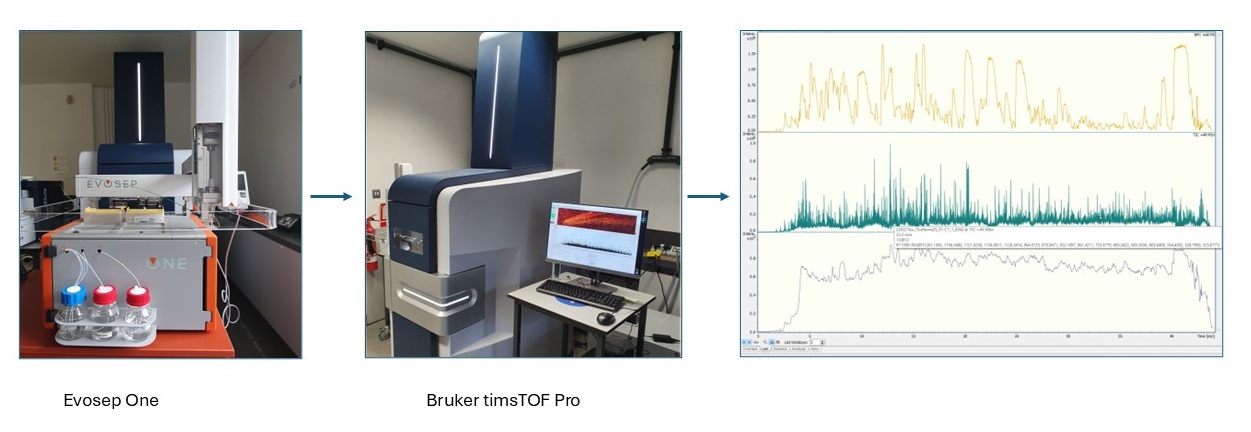Powering Ireland’s Molecular Science Infrastructure - the Comprehensive Molecular Analytical Platform (CMAP)
Research Spotlight
July 2025
Established in early 2020 through funding from the Research Ireland (formerly Science Foundation Ireland) Research Infrastructure Call 2018, the Comprehensive Molecular Analytical Platform (CMAP) represents a strategic national investment in high-resolution molecular analysis. CMAP supports research aligned with Ireland’s economic and scientific priorities in:
- Chemistry
- Bioeconomy
- Synthetic Biology
- Food and Health
- Precision Medicine
CMAP, which originated in Systems Biology Ireland (SBI), hosts its purpose-built mass spectrometry facilities on the University College Dublin (UCD) Belfield campus. Its overall mission is to centralise analytical capacity, foster interdisciplinary collaboration, and accelerate molecular discovery across academic, clinical, and industrial sectors.
“We’re really lucky to have CMAP here at UCD,” said Kieran Wynne, CMAP Infrastructure Manager at SBI. “The powerful analytical capabilities of the machines and the expertise and dedication of the staff running the facilities are second to none. It’s offered a key step forward for many different research projects in Dublin and across the country. We’ve seen the platform usage grow massively over the last five years, and that’s something we hope to continue to build on.”

Strategic Infrastructure Overview
CMAP’s dedicated proteomics and metabolomics instrumentation is housed within the UCD Conway Institute’s Core Facilities, enabling advanced protein and metabolite analytical workflows. Located just a short walk from the UCD Conway Institute, the UCD School of Chemistry hosts CMAP’s chemical analysis/tissue imaging component. This proximity enables integration and collaboration across the CMAP platform.
https://www.ucd.ie/sbi/research/nationalinitiatives/comprehensivemolecularanalysisplatform/
CMAP Proteomics
- 2× Bruker timsTOF Pro MS (DIA-PASEF-based workflows)
- 2× Evosep One (ultra-high throughput nanoflow LC systems)
- 1× KingFisher Flex automated magnetic bead–based sample prep
- Advanced Computational Support:
- 3 dedicated data processing servers
- 3 high-spec search workstations
- 2 storage servers (total 128 TB) for raw data and archives
The Bruker/Evosep instruments enable comprehensive reproducible workflows including deep proteome profiling, phosphoproteomics, affinity enrichment (IP-MS), and interaction network mapping. The computational infrastructure facilitates rapid data processing and integrative systems-level analysis.
CMAP Metabolomics
- SCIEX QTRAP 6500plus MS/ExionLC UHPLC
CMAP`S Sciex mass spectrometry platform enables targeted metabolomics to be conducted on a wide variety of biofluids and matrices such as biofluids (plasma, serum, or urine), tissue, and cell culture samples.
CMAP Chemical Characterisation / Tissue Imaging Unit
- Bruker Autoflex maX MALDI-TOF/TOF
- Agilent Single Quadrupole MS & QToF
The Agilent systems offer high-resolution LC-MS for both quantitative and qualitative analysis, while the Bruker Autoflex maX MALDI-TOF/TOF enables chromatography-free analysis and MALDI-based tissue imaging. Both platforms are suitable for analysing synthetic and biological samples, including proteins, oligosaccharides, polymers, and organometallic compounds.
Impact at Scale: Focus on the CMAP Proteomics Core
The CMAP equipment housed in the UCD Conway Institute Proteomics Core has emerged as one of Ireland’s premier facilities for high-resolution proteomics and advanced MS-based biological investigation.
Key Performance Metrics (2020–2025):
- 25,000 biological samples processed.
- Proteomic analysis for over 60 research groups across multiple disciplines resulting in over 100 peer-reviewed publications generated, playing a pivotal role in studies on human diseases including many types of cancer, COVID-19, ALS, cardiovascular disease, cystic fibrosis, schizophrenia, preeclampsia, HIV and more.
The facility's workflows use data-independent acquisition (DIA) with parallel accumulation–serial fragmentation (PASEF) on the Bruker timsTOF Pro platform. Its integration with Evosep One LC systems ensures robust sample throughput, while in-house computational infrastructure supports rapid data analysis using tools such as DIA-NN, MaxQuant, and Perseus.
In addition, CMAP has been an integral part of a number of high impact recent publications, illustrating its translational relevance across oncology, immunology, neuroscience, ophthalmology, and metabolic disease.
- Rukhlenko et al., Nature (2022): (opens in a new window)Control of cell state transitions
- Fehilly et al., FASEB J (2025): (opens in a new window)Germline Disruption of Retinal Pigment Epithelium-Expressed Zebrafish rlbp1b−/− Results in Selective Dim Light Visual Behavior Deficits and Provides a Screening Platform for Evaluating the Pathogenicity of Human RLBP1 Variants
- Weber et al., Br J Pharmacol (2025): (opens in a new window)Assessment of the molecular mechanisms of drug-induced hidden cardiotoxicity by a multi-omics approach: The example of rofecoxib
- Venkatesh et al., Mol Syst Biol (2025): (opens in a new window)Proteomic compensation by paralogs preserves protein interaction networks after gene loss in cancer
- Singh et al., PNAS (2025): (opens in a new window)De novo DUOX2 expression in neutrophil subsets shapes the pathogenesis of intestinal disease
- Wang et al., Front Immunol (2025): (opens in a new window)The fibrin-derived peptide FX06 protects human pulmonary endothelial cells against the COVID-19-triggered cytokine storm
CMAP—and specifically the UCD Conway Institute Proteomics Core—has proven to be a high-impact national infrastructure with strong research outputs, broad user engagement, and embedded analytical expertise. Building on this success, Systems Biology Ireland is currently working on plans for a national platform for integrated, multi-omic single-cell analysis—a critical frontier in understanding cellular heterogeneity, microenvironmental context, and disease pathogenesis.

Read more about SBI researchers' ground breaking work in our series of "Spotlight" articles